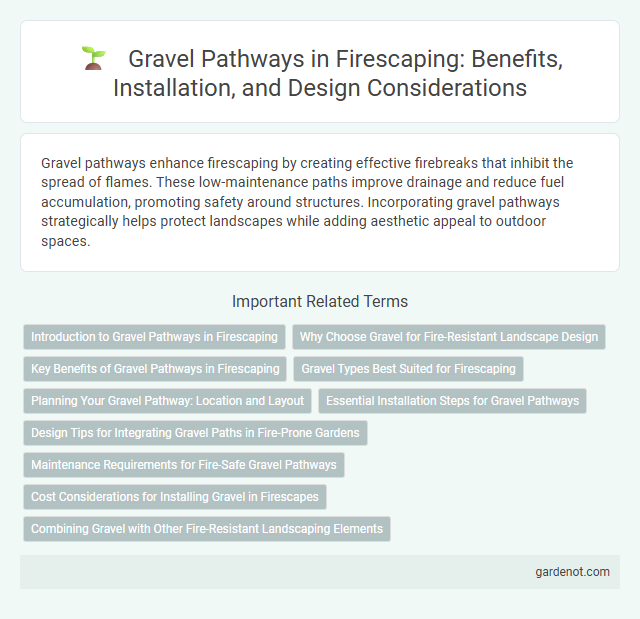Gravel pathways enhance firescaping by creating effective firebreaks that inhibit the spread of flames. These low-maintenance paths improve drainage and reduce fuel accumulation, promoting safety around structures. Incorporating gravel pathways strategically helps protect landscapes while adding aesthetic appeal to outdoor spaces.
Introduction to Gravel Pathways in Firescaping
Gravel pathways in firescaping serve as effective defensible space barriers by restricting the spread of flames and embers near structures. Utilizing non-combustible materials like crushed stone or pea gravel, these pathways reduce fuel continuity, aiding wildfire prevention around homes. Proper installation involves maintaining a minimum width of 3 to 4 feet to ensure adequate clearance and enhance landscape safety in high-risk fire zones.
Why Choose Gravel for Fire-Resistant Landscape Design
Gravel pathways are an excellent choice for fire-resistant landscape design due to their non-combustible nature and ability to act as effective firebreaks, reducing the spread of wildfires near structures. The permeability of gravel also aids in water drainage, preventing dry, flammable conditions that can exacerbate fire risks. Using gravel in firescaping enhances safety while maintaining aesthetic appeal in fire-prone areas.
Key Benefits of Gravel Pathways in Firescaping
Gravel pathways enhance firescaping by creating effective firebreaks that reduce fuel continuity and slow wildfire spread. Their permeability allows rainwater to infiltrate, minimizing erosion and supporting drought-resistant landscaping. Gravel paths also offer low-maintenance, cost-effective solutions that improve property safety while maintaining aesthetic appeal in fire-prone areas.
Gravel Types Best Suited for Firescaping
Crushed granite and decomposed granite are among the best gravel types for firescaping due to their excellent drainage properties and fire-resistant nature. Pea gravel, with its smooth texture and ability to prevent weed growth, also serves as an effective non-flammable ground cover around fire-prone areas. Lava rock offers superb fire resistance and thermal insulation, making it a popular choice for creating safe and visually appealing firebreaks.
Planning Your Gravel Pathway: Location and Layout
Careful planning of your gravel pathway considers location and layout to enhance both functionality and aesthetics. Choose a location that complements your landscape design while avoiding areas prone to water accumulation or heavy foot traffic. Design a layout that follows natural garden contours, providing smooth transitions between outdoor spaces and ensuring proper drainage for long-lasting durability.
Essential Installation Steps for Gravel Pathways
Creating a durable gravel pathway begins with excavating the area to a depth of 4 to 6 inches, followed by installing a weed barrier fabric to prevent weed growth and maintain pathway integrity. Next, lay a base layer of crushed stone or aggregate to enhance drainage and stability, then compact the base using a tamper or plate compactor for a firm foundation. Finally, spread a top layer of decorative gravel evenly, smoothing it out to the desired thickness, ensuring it remains level and well-contained with edging materials to prevent displacement.
Design Tips for Integrating Gravel Paths in Fire-Prone Gardens
Gravel pathways offer excellent fire resistance and improve drainage in fire-prone gardens, making them a smart design choice for reducing wildfire risk. Incorporate smooth, compacted gravel surfaces at least 3 feet wide to create effective firebreaks while maintaining accessibility. Use non-flammable edging materials like metal or stone to keep gravel contained and enhance the pathway's protective function.
Maintenance Requirements for Fire-Safe Gravel Pathways
Gravel pathways designed for fire-safe landscaping require regular maintenance to ensure they remain effective barriers against wildfire spread. Periodic removal of debris, leaves, and other combustible materials prevents fuel accumulation within the gravel, reducing fire risk. Proper grading and replenishment of gravel promote drainage and prevent erosion, maintaining the pathway's fire-resistant properties over time.
Cost Considerations for Installing Gravel in Firescapes
Gravel pathways in firescapes offer an affordable and effective fire-resistant option compared to hardscape materials like concrete or pavers. The cost of installing gravel ranges between $1 to $3 per square foot, influenced by gravel type, depth, and site preparation requirements. Choosing locally sourced gravel and minimal excavation can further reduce expenses, making it a budget-friendly choice for enhancing fire safety in landscaping.
Combining Gravel with Other Fire-Resistant Landscaping Elements
Gravel pathways enhance fire-resistant landscaping by effectively integrating with drought-tolerant plants, stone mulches, and ember-resistant ground covers to create defensible spaces around homes. Using gravel alongside fire-resistant shrubs like manzanita or ceanothus reduces fuel continuity, limiting fire spread and improving landscape safety. Combining these materials increases overall landscape resilience in fire-prone areas, providing both functional safety and aesthetic appeal.
Gravel pathway Infographic

 gardenot.com
gardenot.com